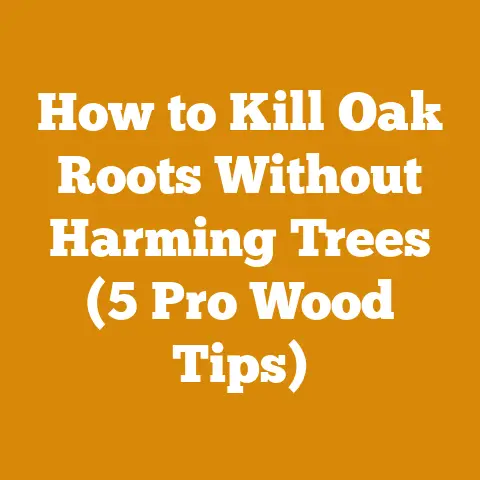How to Chop Down a Small Tree (5 Pro Arborist Tips)
The Crisp Autumn Air and the Whisper of the Woods: A Guide to Felling Small Trees
The smell of damp earth and decaying leaves always brings me back to my early days in the woods. I remember the first time I held a chainsaw, its weight a promise of power and responsibility. My grandfather, a seasoned logger with hands as rough as bark, stood beside me, his eyes crinkled with a mixture of amusement and concern. “A tree is a life, boy,” he said, his voice raspy. “Respect it. And know how to bring it down safely.”
That day, I learned more than just how to start a chainsaw. I learned the importance of planning, precision, and respect for the environment. Over the years, I’ve felled countless trees, from saplings to towering giants, each experience etching valuable lessons into my memory.
Today, I want to share some of those lessons with you, specifically focusing on how to safely and efficiently fell small trees. While the scale might be smaller, the principles of safety and technique remain paramount.
Key Takeaways: What You’ll Learn
Before we dive in, here’s a quick overview of what you’ll learn in this article:
- Understanding the Risks: Recognizing the potential dangers involved in tree felling, even with small trees.
- Essential Safety Gear: Knowing what personal protective equipment (PPE) is crucial for safe operation.
- Pre-Felling Assessment: Evaluating the tree, its surroundings, and potential hazards.
- Mastering the Felling Cuts: Learning the proper techniques for the notch cut, back cut, and hinge wood.
- Controlling the Fall: Using wedges and other techniques to ensure the tree falls in the desired direction.
1. The Unseen Dangers: Why Even Small Trees Demand Respect
It’s easy to underestimate the danger involved in felling small trees. After all, they’re not towering giants, right? Wrong. Even a small tree can cause serious injury if it falls unexpectedly or in the wrong direction. The force of gravity, combined with the weight of the wood, can be a recipe for disaster.
I remember one time, working with a crew clearing brush, a seemingly harmless sapling snapped back with surprising force after being cut, striking a colleague in the shoulder. Thankfully, he was wearing a hard hat and shoulder protection, which mitigated the injury, but it was a stark reminder that complacency can be deadly.
Here are some of the potential hazards to keep in mind:
- Snap-Back: Small trees, especially those under tension, can snap back violently after being cut.
- Falling Limbs: Even small trees can have dead or weakened limbs that can fall unexpectedly.
- Uneven Terrain: Slopes, rocks, and other obstacles can make it difficult to maintain your balance and control the saw.
- Hidden Obstacles: Fences, power lines, and other structures can be damaged by a falling tree.
- Human Error: Misjudging the lean of the tree, making improper cuts, or failing to use wedges can all lead to accidents.
Data Point: According to the Occupational Safety and Health Administration (OSHA), logging is one of the most dangerous occupations in the United States, with a fatality rate significantly higher than the national average. While these statistics encompass all logging activities, they underscore the inherent risks associated with tree felling, regardless of the tree’s size.
2. Gearing Up for Success: Essential Personal Protective Equipment (PPE)
Before you even think about starting your chainsaw, make sure you’re wearing the proper personal protective equipment (PPE). This isn’t just a suggestion; it’s a necessity. Your PPE is your first line of defense against injury.
Here’s a checklist of essential PPE:
- Chainsaw Helmet: A helmet is non-negotiable. It protects your head from falling limbs and debris. Look for a helmet that meets ANSI Z89.1 standards.
- Hearing Protection: Chainsaws are loud, and prolonged exposure to high noise levels can cause permanent hearing damage. Wear earplugs or earmuffs with a Noise Reduction Rating (NRR) of at least 25 dB. I usually use electronic earmuffs; they allow me to hear my surroundings while still blocking out the harmful chainsaw noise.
- Eye Protection: Sawdust, wood chips, and other debris can easily get into your eyes, causing irritation or injury. Wear safety glasses or a face shield.
- Chainsaw Chaps: These are designed to stop a chainsaw chain in its tracks, preventing serious leg injuries. They’re made of multiple layers of tough, synthetic fibers that clog the saw’s mechanism upon contact. Always wear chainsaw chaps when operating a chainsaw.
- Gloves: Gloves provide a better grip on the chainsaw and protect your hands from cuts, abrasions, and vibrations. Look for gloves specifically designed for chainsaw use.
- Steel-Toed Boots: Protect your feet from falling objects and provide a stable base for working.
- First-Aid Kit: Always have a well-stocked first-aid kit on hand in case of an injury.
Expert Insight: “Proper PPE is the most important investment you can make when working with chainsaws,” says Mark Johnson, a certified arborist with over 20 years of experience. “It’s not just about following the rules; it’s about protecting yourself from potentially life-altering injuries.”
3. Reading the Tree: Pre-Felling Assessment
Before you make a single cut, take the time to carefully assess the tree and its surroundings. This is arguably the most critical step in the entire process. A thorough assessment will help you identify potential hazards and plan your felling strategy.
Here’s what to look for:
- Lean: Determine the natural lean of the tree. This is the direction the tree will most likely fall. You can use a plumb bob or simply sight along the trunk to determine the lean.
- Wind: Pay attention to the wind direction and strength. Wind can significantly affect the direction of the fall. Never fell a tree in high winds.
- Obstacles: Identify any obstacles that could interfere with the fall, such as power lines, fences, buildings, or other trees.
- Dead or Weak Limbs: Look for any dead, broken, or weakened limbs that could fall unexpectedly.
- Decay: Check for signs of decay in the trunk or branches. Decay can weaken the tree and make it unpredictable.
- Surrounding Terrain: Assess the terrain around the tree. Uneven ground, slopes, and obstacles can make it difficult to maintain your balance and control the saw.
- Escape Route: Plan a clear escape route that is at a 45-degree angle away from the direction of the fall. Make sure the path is clear of obstacles.
Personal Story: I once misjudged the lean of a small tree because I didn’t account for the weight of a large branch on one side. As a result, the tree fell in the opposite direction I intended, narrowly missing a fence. That experience taught me the importance of paying attention to every detail during the pre-felling assessment.
4. The Art of the Cut: Mastering the Felling Techniques
Once you’ve assessed the tree and planned your felling strategy, it’s time to make the cuts. The key to a safe and controlled fall is to use the proper techniques for the notch cut, back cut, and hinge wood.
4.1 The Notch Cut (aka the Face Cut)
The notch cut determines the direction of the fall. It’s a wedge-shaped cut that is made on the side of the tree facing the direction you want it to fall.
-
Types of Notch Cuts: There are two main types of notch cuts: the open-face notch and the conventional notch. The open-face notch is generally preferred because it provides better control and reduces the risk of barber-chairing (when the tree splits vertically during the fall).
- Open-Face Notch: This notch consists of two cuts: a top cut at a 70-degree angle and a bottom cut that meets the top cut at a 20-degree angle. The combined angle of the notch should be 90 degrees.
- Conventional Notch: This notch consists of a top cut at a 45-degree angle and a bottom cut that meets the top cut at a 45-degree angle. The combined angle of the notch should be 90 degrees.
-
Making the Notch Cut:
-
Stand on the uphill side of the tree, if possible.
- Position yourself so that you have a clear view of the notch and the surrounding area.
- Start the top cut of the notch, aiming for the center of the tree.
- Make the bottom cut, meeting the top cut at the desired angle.
- Remove the wedge of wood from the notch.
4.2 The Back Cut
The back cut is made on the opposite side of the tree from the notch cut. It’s the final cut that releases the tree and allows it to fall.
- Importance of Hinge Wood: The back cut should never meet the notch cut. You need to leave a strip of wood, called the hinge wood, between the back cut and the notch cut. The hinge wood controls the direction of the fall and prevents the tree from kicking back towards you. The hinge should be about 10% of the tree’s diameter for smaller trees.
-
Making the Back Cut:
- Position yourself on the opposite side of the tree from the notch cut.
- Start the back cut slightly above the bottom of the notch cut.
- Cut straight into the tree, leaving the hinge wood intact.
- As the tree begins to fall, step away quickly and safely, following your planned escape route.
4.3 Barber Chairing
Barber chairing is a dangerous situation where the tree splits vertically during the fall. This can happen if the back cut is made too high or if the tree is under tension. To prevent barber chairing, use the open-face notch cut and make sure the back cut is at the correct height.
Data Point: A study by the Forest Products Laboratory found that using the open-face notch cut reduces the risk of barber chairing by up to 50% compared to the conventional notch cut.
5. Taking Control: Wedges and Other Techniques
Sometimes, the natural lean of the tree isn’t in the direction you want it to fall. In these cases, you can use wedges to help control the fall.
-
Using Wedges: Wedges are inserted into the back cut to help push the tree in the desired direction. They’re especially useful for trees that are leaning slightly in the wrong direction or for trees that are heavy on one side.
- Make the back cut as described above, leaving the hinge wood intact.
- Insert one or more wedges into the back cut.
- Use a hammer or axe to drive the wedges further into the cut, gradually pushing the tree in the desired direction.
- Continue driving the wedges until the tree begins to fall.
- Step away quickly and safely, following your planned escape route.
-
Pulling Ropes: For more precise control, you can use a pulling rope attached to the upper part of the tree. This allows you to pull the tree in the desired direction as it falls. This is generally for more experienced individuals.
- Attach a strong rope to the upper part of the tree, as high as possible.
- Secure the other end of the rope to a vehicle or a winch.
- Make the notch cut and back cut as described above, leaving the hinge wood intact.
- As the tree begins to fall, use the rope to pull it in the desired direction.
- Step away quickly and safely, following your planned escape route.
Expert Quote: “Wedges are your best friend when felling trees,” says Sarah Miller, a professional logger with over 15 years of experience. “They give you the leverage you need to control the fall and prevent accidents.”
6. Chainsaw Maintenance: Keeping Your Saw in Top Shape
A well-maintained chainsaw is a safe chainsaw. Regular maintenance will not only prolong the life of your saw but also ensure that it operates safely and efficiently.
Here are some essential chainsaw maintenance tasks:
- Sharpening the Chain: A dull chain is a dangerous chain. It requires more force to cut, which can increase the risk of kickback. Sharpen the chain regularly using a chainsaw file or a chain grinder.
- Cleaning the Air Filter: A dirty air filter can restrict airflow to the engine, causing it to run poorly. Clean the air filter regularly with compressed air or soap and water.
- Checking the Spark Plug: A fouled spark plug can cause the engine to misfire or not start at all. Check the spark plug regularly and replace it if necessary.
- Lubricating the Chain: Keep the chain properly lubricated to reduce friction and wear. Use a high-quality bar and chain oil.
- Checking the Bar: Inspect the bar for wear and damage. Replace the bar if it is bent, cracked, or worn.
- Adjusting the Chain Tension: Proper chain tension is essential for safe and efficient operation. Adjust the chain tension regularly according to the manufacturer’s instructions.
Data Point: A study by Oregon State University found that properly maintained chainsaws are up to 20% more efficient than poorly maintained chainsaws.
7. Dealing with Hang-Ups: What to Do When Things Go Wrong
Sometimes, despite your best efforts, a tree will get hung up in another tree during the fall. This can be a dangerous situation, as the hung-up tree can fall unexpectedly at any time.
Never attempt to climb a hung-up tree or shake it down. This is extremely dangerous.
Here are some safer options:
- Use a Peavey or Cant Hook: A peavey or cant hook is a long-handled tool with a hook on the end that can be used to roll or lift logs. Use the peavey or cant hook to try to dislodge the hung-up tree from the ground.
- Use a Winch: If the tree is too heavy to move with a peavey or cant hook, use a winch to pull it down. Attach the winch cable to the base of the hung-up tree and slowly pull it down.
- Call a Professional: If you’re not comfortable dealing with a hung-up tree, call a professional arborist or logger. They have the experience and equipment to safely remove the tree.
Personal Experience: I once tried to dislodge a hung-up tree by throwing a rope over a branch and pulling on it. The branch snapped, sending me sprawling to the ground. I was lucky to escape with only a few bruises. That experience taught me the importance of using the right tools and techniques for the job.
8. After the Fall: Clean Up and Follow-Up
Once you’ve felled the tree, the job isn’t quite done. You need to clean up the area and follow up to ensure that everything is safe.
- Limbing and Bucking: Remove the branches from the felled tree (limbing) and cut the trunk into manageable lengths (bucking).
- Stacking Firewood: If you’re using the wood for firewood, stack it in a dry, well-ventilated area.
- Disposing of Debris: Dispose of any debris, such as branches, leaves, and sawdust, in an environmentally responsible manner.
- Inspecting the Area: Inspect the area for any potential hazards, such as unstable trees or exposed roots.
- Replanting: Consider planting a new tree to replace the one you felled.
9. Legal Considerations: Permits and Regulations
Before you start felling trees, check with your local authorities to see if you need a permit. Many municipalities have regulations regarding tree removal, especially for trees that are located on public property or in protected areas.
Case Study: In some areas, homeowners are required to obtain a permit before removing any tree with a diameter of more than 6 inches. Failure to obtain a permit can result in fines and other penalties.
10. Continuous Learning: Sharpening Your Skills
Tree felling is a skill that requires continuous learning and practice. Take advantage of opportunities to learn from experienced professionals and to improve your techniques.
- Attend Workshops and Seminars: Many organizations offer workshops and seminars on tree felling and chainsaw safety.
- Read Books and Articles: There are many excellent books and articles available on tree felling and chainsaw safety.
- Watch Videos: Watch videos of experienced professionals felling trees.
- Practice Regularly: The more you practice, the better you’ll become at felling trees safely and efficiently.
Final Thoughts: Respect the Power, Master the Skill
Felling trees, even small ones, is a serious undertaking that demands respect, knowledge, and skill. By following the tips and techniques outlined in this article, you can significantly reduce the risk of accidents and ensure that you’re felling trees safely and efficiently. Remember to always prioritize safety, wear the proper PPE, and take the time to assess the tree and its surroundings before you make a single cut.
Actionable Next Steps:
- Review this article: Make sure you understand the key concepts and techniques.
- Gather your PPE: Ensure you have all the necessary safety gear.
- Practice on small, non-essential trees: Get comfortable with the techniques before tackling larger or more valuable trees.
- Consider taking a chainsaw safety course: A professional course can provide valuable hands-on training and guidance.
- Always prioritize safety: Never take risks or cut corners when felling trees.
Remember my grandfather’s words: “A tree is a life. Respect it.” With careful planning, proper technique, and a healthy dose of respect, you can safely and efficiently fell small trees and enjoy the satisfaction of working with wood. Now, go forth and fell those trees, but do it safely!






